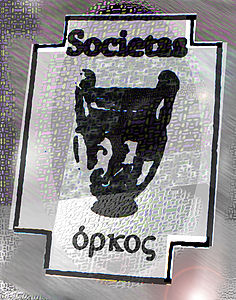- One-in-a-Thousand Society
-
One-in-a-Thousand Society (OATHS) Formation 1992 Type High IQ society[1] Membership cca. >100 (Sept. 2011) Founder Ronald K. Hoeflin, Ph.D. Key people President, Tom Caulfield, Ph.D. Website [1] OATHS Society[2],[3],[4],[5] is an international society for people who have a documented IQ score of at least 150 sd16 from standardized, professional tests of intelligence. This means that membership is open for the top 0.1% of people, percentile 99.9 along the IQ spectrum,[1] or roughly 1 in 1,000 people. For comparison Mensa, the most widely recognized IQ organization, accepts people scoring in the top 2% or an IQ of 133 sd16. In relation, this means that OATHS is ~20 times more selective than Mensa, in terms of IQ scores.
Contents
Beginnings
OATHS was founded by philosopher Ronald K. Hoeflin, Ph.D., aiming to facilitate the interaction of individuals with a very high IQ. Currently, OATHS is part of the umbrella organization the Lewis M. Terman Society, administered by Dr. Hernan Chang. The presiding OATH society president is Tom Caulfield, Ph.D. There are several notable members of OATHS Society who hold membership in the Prometheus Society as well [6],[4],[7]. Ongoing research into the structural and neural basis for intelligence are some of the core activities undertaken by these societies[8],[9]. With such small population sets able to score 4 or more deviations above the "middle-range", makes such scaling a difficult task;[10] one that Paul Cooijmans[11] continues to study with statistical methods.
Admission
To become a member of OATHS, one must provide a documented evidence of a performance at or above the 99.9th percentile (an IQ of 150 sd16) on standardized, professional tests of intelligence. Some of the recognized tests are:[1]
- Scores accepted for admission to the OATHS Society
- 1. Stanford-Binet: older versions 150 IQ.
- 2. Terman Concept Mastery Test (form T): 157 raw score.
- 3. Graduate Record Examination (GRE): 2180 (Verbal & Quantitative + Math).
- 4. California Test of Mental Maturity: 99.9%
- 5. Miller Analogies Test: old version: 91 out of 100. Recent version scaling: 472 scaled.
- 6. Wechsler Adult Intelligence Scale: 147 IQ.
- 7. Wechsler Intelligence Scale for Children: 160 IQ.
- 8. Scholastic Aptitude Test (SAT): To mid-1995: 1450 (V & Q); after mid-1995: 1520.
- 10. Cattell Verbal: 99.9%.
- 11. ACT (American College Testing Program): 32 out of 36
- 12. Titan Test: 24 raw score out of 48.
NOTE: Some tests, or versions of tests, do not provide a high-enough ceiling, for a range of scores, to determine IQ for membership. Such tests are "too easy" or fail otherwise. Some other tests are accepted, such as those designed by Paul Cooijmans.[1]
Notable members
- Don Stoner, physicist, author[12], and inventor[13]
- Tom Caulfield, Ph.D., author[14], and writer
- Ronald K. Hoeflin, Ph.D., philosopher[15]
See also
- Levels of Measurement: Ordinal Scale
References
- ^ a b c d "OATHS Society - Membership", 2010, webpage: ES-memb.
- ^ . http://www.eskimo.com/~miyaguch/oath.html.
- ^ . http://prometheussociety.org/links/index.html.
- ^ a b . http://prometheussociety.org/officers/index.html.
- ^ . http://prometheussociety.org/links/gof_online_issues.html.
- ^ . http://prometheussociety.org/links/index.html.
- ^ . http://www.PrometheusSociety.org/gof_online_issues.html.
- ^ Ardila, Alfredo; David Pineda, Mónica Rosselli (2000). "Correlation Between Intelligence Test Scores and Executive Function Measures". Archives of Clinical Neuropsychology (Oxford Journals): pp. 31–36. http://acn.oxfordjournals.org/cgi/content/short/15/1/31. Retrieved 2000-12-22.
- ^ Duncan, John; Ru¬diger J. Seitz, Jonathan Kolodny, Daniel Bor, Hans Herzog, Ayesha Ahmed, Fiona N. Newell, Hazel Emslie1 (July 2000). "A Neural Basis for General Intelligence". SCIENCE (Journal, Impact Factor 32) (AAAS): pp. 457–461. http://search.bwh.harvard.edu/concourse/900/articles/DuncanBrain_gScience00.pdf. Retrieved 2000-07-01.
- ^ Perleth, Christoph; Schatz, Tanja; Mönks, Franz J. (2000). "Early Identification of High Ability". In Heller, Kurt A.; Mönks, Franz J.; Sternberg, Robert J. et al.. International Handbook of Giftedness and Talent (2nd ed.). Amsterdam: Pergamon. p. 301. ISBN 978-0-08-043796-5. "norm tables that provide you with such extreme values are constructed on the basis of random extrapolation and smoothing but not on the basis of empirical data of representative samples."
- ^ . http://www.iq-tests-for-the-high-range.com/.
- ^ Stoner, Don (July 1997). "A New Look at an Old Earth". Harvest House Pub. pp. 256. http://www.amazon.com/Earth-Resolving-Conflict-Between-Science/dp/1565075951. Retrieved 2007-09-09.
- ^ U.S. Patent 4,611,996, U.S. Patent 4,768,195, U.S. Patent 7,448,935
- ^ Caulfield, Tom (July 1998). "The arc of being: epochs I-IV". Springer-Verlag. pp. 444.
- ^ Aviv, Rachel (2006-08-01). "The Intelligencer". Village Voice. http://www.villagevoice.com/arts/0631,aviv,74027,12.html. Retrieved 2007-09-09.
External links
- OATHS Society homepage
- High-IQ Societies and the Tests They Accept for Admission Purposes
- Other High IQ Societies on the Web.
High IQ Topics Groups Testing Stanford-Binet · Miller Analogies Test · Wechsler Adult Intelligence Scale · Graduate Record Examination · Army General Classification Test · Cattell Culture Fair · Wechsler Intelligence Scale for Children · American College Testing Program (ACT) · Scholastic Aptitude Test (SAT)Related Densa (parody)Categories:- High IQ societies
Wikimedia Foundation. 2010.

